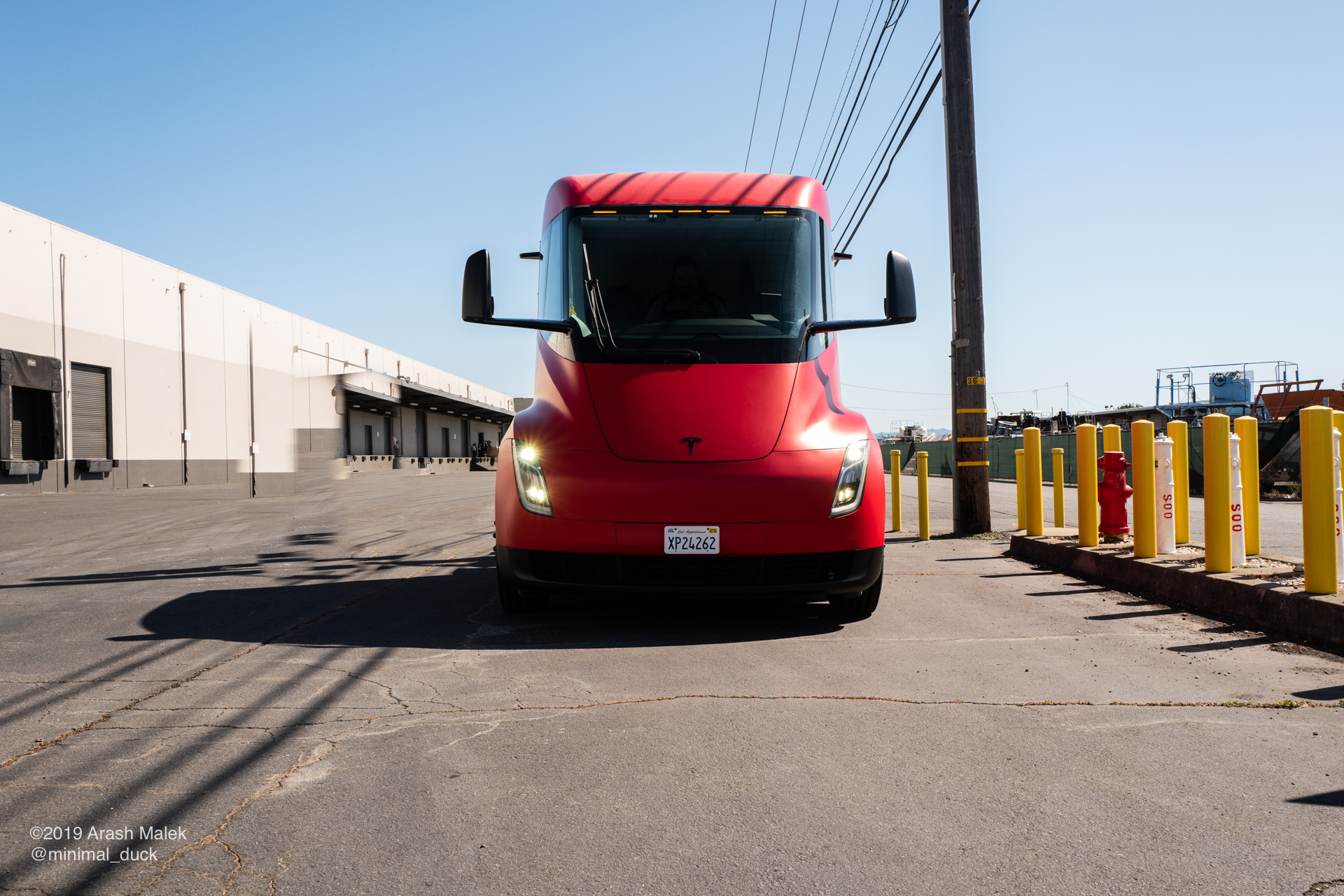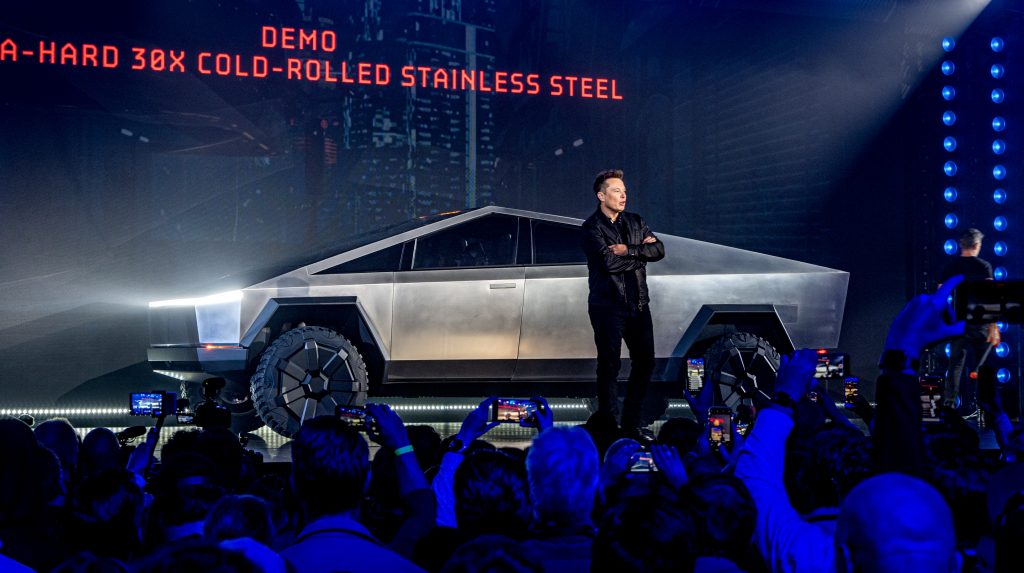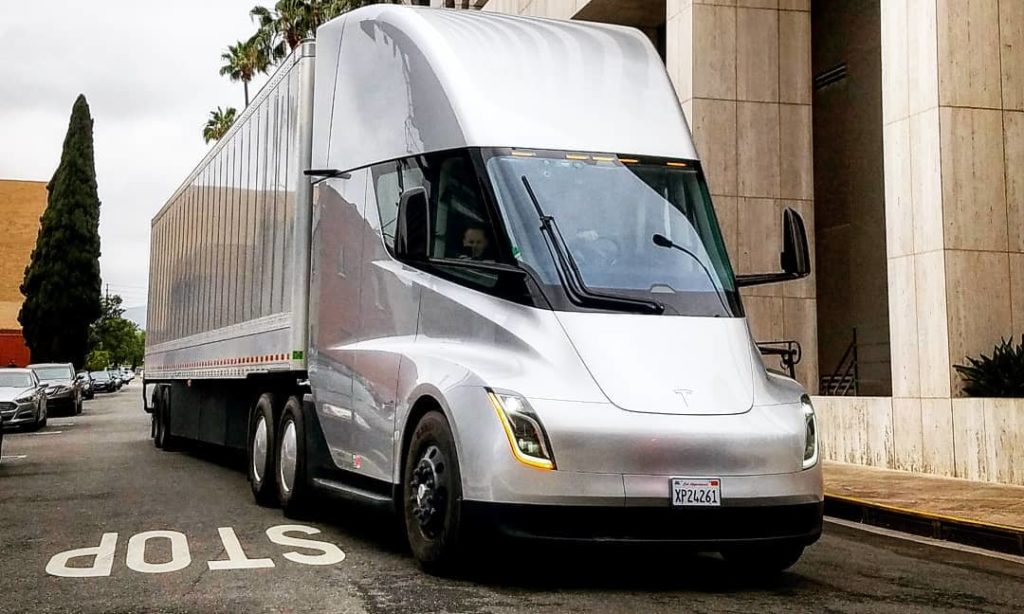

News
Tesla’s battery strategy will be key to Cybertruck and Semi’s market disruption
Elon Musk has remarked that Tesla has arguably the most exciting product roadmap of any company today. With vehicles like the Semi and the Cybertruck coming in the pipeline, this statement rings true. But things will not be as easy as simply setting up production lines for the upcoming vehicles. For Tesla to properly ramp the Semi, for example, the company would have to make sure that it can get enough cells for the vehicle first.
Producing electric cars is no easy task, and a lot of the challenges in EV making are connected in one way or another to vehicles’ batteries. This is something that is being learned by veteran carmakers like Jaguar today, as inadequate supply from battery companies like LG Chem has resulted in a halt of production for premium EVs like the I-PACE. Tesla is certainly aware of the battery supply challenges that EV makers face. This is one of the reasons why Gigafactory Nevada was constructed.
Giga Nevada was built to support the company’s Model 3 ramp. Designed to manufacture the 2170 cells of the Model 3 with battery partner Panasonic, the massive facility forms the backbone of Tesla’s first foray into the mass market. But the story lies far beyond the Model 3 today. Tesla has an even higher-volume vehicle coming, the Model Y. The Cybertruck will likely sell in large volumes too, provided that the market embraces it. Just like the all-electric pickup, the Semi might see sufficient demand from the trucking market once it’s released as well, considering the cost benefits that the vehicle offers.

Tesla is in a constant state of change, and this cannot be represented better than the company’s batteries. President of Automotive Jerome Guillen has noted that Tesla’s batteries are never static since they’re always being improved. Today, it is becoming more and more evident that Tesla’s batteries are among the best in the industry, particularly when it comes to energy density. Coupled with its vertically-integrated software, Tesla’s batteries can give vehicles impressive range even if they are not too large.
The Model 3, for example, can squeeze out over 320 miles of range from a 75 kWh battery, and the Model S Long Range Plus can get 390 miles from a 100 kWh pack. This matters a lot, and it shows just how far ahead the company is when it comes to its batteries and their energy density. And this, ultimately, will likely help the company secure enough battery cells to support the ramp of its upcoming EVs, including the Semi and the Cybertruck, both of which are large vehicles that would usually require a massive pack to hit their target range.
Tesla lists the Semi with a range of 300 to 500 miles. The company never announced the size of the Semi’s battery pack, but considering that the vehicle is a Class 8 truck that can accelerate from 0-60 mph in 20 seconds with a full load, speculations for the vehicle’s battery from the EV community included estimates that were as high as 1 MWh. The same concept applies to the Cybertruck. The vehicle is very heavy, and it is expected to have over 500 miles of range. To get this range, a large battery pack would usually be required.

But with Tesla’s constant innovations on its batteries, this does not necessarily have to be the case. Considering that Tesla is closing in on 400 miles per charge on a 100 kWh pack with the Model S, there is a good chance that its next vehicles like the Cybertruck and Semi will be equipped with fewer, but more energy-dense cells than initially expected. Tesla has pretty much developed the skill of drawing out as much range as possible from every cell in an EV, so it’s not too farfetched to infer that the company will be very efficient with the batteries of its upcoming vehicles.
More energy-dense batteries will be key to lowering production costs as well. Tesla may be drastically reducing its battery costs, but the packs themselves still comprise a huge portion of each of its vehicles’ prices. If Tesla can use slightly smaller packs that are still capable of providing optimum range, Tesla can make sure that its EVs like the Semi and the Cybertruck will be as competitive as possible when they enter the market.
The Tesla Semi and the Cybertruck are competing in the trucking and pickup market, two very lucrative segments in the automotive industry. Interestingly, both segments are also ripe for disruption, with most veterans such as Freightliner and the Ford F-150 sticking to tried and tested strategies to thrive today. Tesla needs a key to ensure that it can have a fighting chance when it enters the trucking and pickup segment with the Semi and Cybertruck. If challenges faced by electric car makers today are any indication, it appears that batteries and their energy density will be the difference-maker. Fortunately, these just happen to be two things that Tesla has been obsessively pursuing since the company was founded less than 17 years ago.
News
Tesla UK sales see 14% year-over-year rebound in June: SMMT data
The SMMT stated that Tesla sales grew 14% year-over-year to 7,719 units in June 2025.

Tesla’s sales in the United Kingdom rose in June, climbing 14% year-over-year to 7,719 units, as per data from the Society of Motor Manufacturers and Traders (SMMT). The spike in the company’s sales coincided with the first deliveries of the updated Model Y last month.
Model Y deliveries support Tesla’s UK recovery
Tesla’s June performance marked one of its strongest months in the UK so far this year, with new Model Y deliveries contributing significantly to the company’s momentum.
While the SMMT listed Tesla with 7,719 deliveries in June, independent data from New AutoMotive suggested that the electric vehicle maker registered 7,891 units during the month instead. However, year-to-date figures for Tesla remain 2% down compared to 2024, as per a report from Reuters.
While Tesla made a strong showing in June, rivals are also growing. Chinese automaker BYD saw UK sales rise nearly fourfold to 2,498 units, while Ford posted the highest EV growth among major automakers, with a more than fourfold increase in the first half of 2025.
Overall, the UK’s battery electric vehicle (BEV) demand surged 39% to to 47,354 units last month, helping push total new car sales in the UK to 191,316 units, up 6.7% from the same period in 2024.
EV adoption accelerates, but concerns linger
June marked the best month for UK car sales since 2019, though the SMMT cautioned that growth in the electric vehicle sector remains heavily dependent on discounting and support programs. Still, one in four new vehicle buyers in June chose a battery electric vehicle.
SMMT Chief Executive Mike Hawes noted that despite strong BEV demand, sales levels are still below regulatory targets. “Further growth in sales, and the sector will rely on increased and improved charging facilities to boost mainstream electric vehicle adoption,” Hawes stated.
Also taking effect this week was a new US-UK trade deal, which lowers tariffs on UK car exports to the United States from 27.5% to 10%. The agreement could benefit UK-based EV producers aiming to expand across the country.
News
Tesla Model 3 ranks as the safest new car in Europe for 2025, per Euro NCAP tests
Despite being on the market longer than many of its rivals, the Tesla Model 3 continues to set the bar for vehicle safety.

The Tesla Model 3 has been named the safest new car on sale in 2025, according to the latest results from the Euro NCAP. Among 20 newly tested vehicles, the Model 3 emerged at the top of the list, scoring an impressive 359 out of 400 possible points across all major safety categories.
Tesla Model 3’s safety systems
Despite being on the market longer than many of its rivals, the Tesla Model 3 continues to set the bar for vehicle safety. Under Euro NCAP’s stricter 2025 testing protocols, the electric sedan earned 90% for adult occupant protection, 93% for child occupant protection, 89% for pedestrian protection, and 87% for its Safety Assist systems.
The updated Model 3 received particular praise for its advanced driver assistance features, including Tesla’s autonomous emergency braking (AEB) system, which performed well across various test scenarios. Its Intelligent Speed Assistance and child presence detection system were cited as noteworthy features as well, as per a WhatCar report.
Other notable safety features include the Model 3’s pedestrian-friendly pop-up hood and robust crash protection for both front and side collisions. Euro NCAP also highlighted the Model 3’s ability to detect vulnerable road users during complex maneuvers, such as turning across oncoming traffic.
Euro NCAP’s Autopilot caution
While the Model 3’s safety scores were impressive across the board, Euro NCAP did raise concerns about driver expectations of Tesla’s Autopilot system. The organization warned that some owners may overestimate the system’s capabilities, potentially leading to misuse or inattention behind the wheel. Even so, the Model 3 remained the highest-scoring vehicle tested under Euro NCAP’s updated criteria this year.
The Euro NCAP’s concerns are also quite interesting because Tesla’s Full Self-Driving (FSD) Supervised, which is arguably the company’s most robust safety suite, is not allowed for public rollout in Europe yet. FSD Supervised would allow the Model 3 to navigate inner city streets with only minimal human supervision.
Other top scorers included the Volkswagen ID.7, Polestar 3, and Geely EX5, but none matched the Model 3’s total score or consistency across categories. A total of 14 out of 20 newly tested cars earned five stars, while several models, including the Kia EV3, MG ZS, and Renault 5, fell short of the top rating.
Elon Musk
Why Tesla’s Q3 could be one of its biggest quarters in history
Tesla could stand to benefit from the removal of the $7,500 EV tax credit at the end of Q3.

Tesla has gotten off to a slow start in 2025, as the first half of the year has not been one to remember from a delivery perspective.
However, Q3 could end up being one of the best the company has had in history, with the United States potentially being a major contributor to what might reverse a slow start to the year.
Earlier today, the United States’ House of Representatives officially passed President Trump’s “Big Beautiful Bill,” after it made its way through the Senate earlier this week. The bill will head to President Trump, as he looks to sign it before his July 4 deadline.
The Bill will effectively bring closure to the $7,500 EV tax credit, which will end on September 30, 2025. This means, over the next three months in the United States, those who are looking to buy an EV will have their last chance to take advantage of the credit. EVs will then be, for most people, $7,500 more expensive, in essence.
The tax credit is available to any single filer who makes under $150,000 per year, $225,000 a year to a head of household, and $300,000 to couples filing jointly.
Ending the tax credit was expected with the Trump administration, as his policies have leaned significantly toward reliance on fossil fuels, ending what he calls an “EV mandate.” He has used this phrase several times in disagreements with Tesla CEO Elon Musk.
Nevertheless, those who have been on the fence about buying a Tesla, or any EV, for that matter, will have some decisions to make in the next three months. While all companies will stand to benefit from this time crunch, Tesla could be the true winner because of its sheer volume.
If things are done correctly, meaning if Tesla can also offer incentives like 0% APR, special pricing on leasing or financing, or other advantages (like free Red, White, and Blue for a short period of time in celebration of Independence Day), it could see some real volume in sales this quarter.
You can now buy a Tesla in Red, White, and Blue for free until July 14 https://t.co/iAwhaRFOH0
— TESLARATI (@Teslarati) July 3, 2025
Tesla is just a shade under 721,000 deliveries for the year, so it’s on pace for roughly 1.4 million for 2025. This would be a decrease from the 1.8 million cars it delivered in each of the last two years. Traditionally, the second half of the year has produced Tesla’s strongest quarters. Its top three quarters in terms of deliveries are Q4 2024 with 495,570 vehicles, Q4 2023 with 484,507 vehicles, and Q3 2024 with 462,890 vehicles.
-

 Elon Musk4 days ago
Elon Musk4 days agoTesla investors will be shocked by Jim Cramer’s latest assessment
-

 News1 week ago
News1 week agoTesla Robotaxi’s biggest challenge seems to be this one thing
-

 Elon Musk2 weeks ago
Elon Musk2 weeks agoFirst Look at Tesla’s Robotaxi App: features, design, and more
-

 News2 weeks ago
News2 weeks agoSpaceX and Elon Musk share insights on Starship Ship 36’s RUD
-

 News2 weeks ago
News2 weeks agoWatch Tesla’s first driverless public Robotaxi rides in Texas
-

 News1 week ago
News1 week agoWatch the first true Tesla Robotaxi intervention by safety monitor
-

 News2 weeks ago
News2 weeks agoTesla has started rolling out initial round of Robotaxi invites
-

 Elon Musk2 weeks ago
Elon Musk2 weeks agoTesla to launch in India in July with vehicles already arriving: report

















